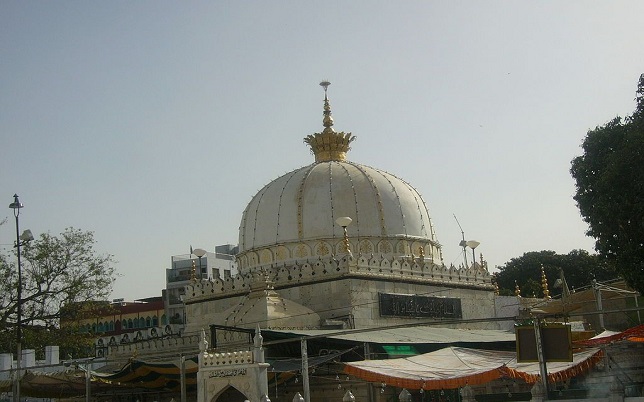The Indo-Pakistan sub-continent ruled for about a thousand years by the Muslims has witnessed many vicissitudes. Great empires have risen and fallen, pompous emperors and mighty conquerors have appeared on the Indian soil and have gone. Their mortal remains enshrined in magnificent tombs scattered all over the sub-continent have become relics of the past.
The tomb of Khwaja Moinuddin Chishti, the saint of Ajmer and the uncrowned spiritual monarch of the sub-continent who still reigns over the hearts of millions of people, is the popular place of pilgrimage of the Muslims drawn from all parts of the world.
Contents
Khwaja Gharib Nawaz
Khwaja Sahib, popularly known as “Gharib Nawaz” (Benefactor of the Poor), had earned this title due to his service to humanity and love for the poor and downtrodden.
A man of indomitable will and dauntless courage, he dedicated his life to the love of God and His creatures. He achieved his mission despite insuperable obstacles and insurmountable difficulties.
Initial Life of Khwaja Moinuddin Chishti
Khwaja Moinuddin Chishti was born in Siestan (Southern Iran) on Rajab 14, 530 Hijri i.e 1142 A.C. He was a Husaini Syed from his father’s side and a Hasani Syed from his mother’s side.
His father, Syed Ghiasuddin Ahmad was a very learned and devout person. He carried on a modest business and owned an orchard.
His father who had migrated to Khorasan, died at Neshapur in 545 Hijri leaving behind him an orchard and a flour mill. Khwaja Moinuddin was then hardly 15 years old.
The Muslim world at this time was passing through a critical period of its history. The Abbasid Caliphate of Baghdad was tottering.
The Caliph was sunk in a life of pomp and pleasure and exercised little hold over the once vast empire, whose far-flung parts were getting independent of the Central control. Baghdad, however, the Metropolis of the Caliphate, was still the cultural, spiritual and educational centre of Islam.
The young Khwaja soon came under the influence of Sufi Ibrahim Qandozi. He sold his orchard and the mill, distributed the money among the poor and embarked up on a spiritual pilgrimage which in itself makes a fascinating story, deserving to be better known in detail.
Mission of Khwaja Moinuddin Chishti
He set out on his noble mission to establish the kingdom of God on earth. His life provides a beacon light to all those struggling for a noble cause. In this difficult task, he was assisted in the end by a few disciples but throughout his life he was without any worldly means whatsoever.
Meeting of Khwaja Moinuddin with Great Saints of the World
In the Shawwal of 560 Hijri the Khwaja became a disciple of Hazrat Usman Harooni, follower of Khwaja Ishaq Ghani Chishti, founder of the Chishtia Order.
Khwaja Sahib served his teacher for 20 years, spending most of his time in prayers and meditation. This was the period of his preparation for the great mission lying ahead of him.
Thereafter taking leave of Khwaja Ishaq Ghani, he proceeded to the Holy cities of Makkah and Medina for pilgrimage.
On accomplishing this task, he went to Sanjar and met Sheikh Najmuddin Kubra and stayed with him for 2.5 years.
Then he proceeded to Gilan, where he paid his respects to the celebrated Saint Hazrat Abdul Qadir Jilani, founder of the Qadiria Order and along with him came to Baghdad. Here he met Sheikh Ziauddin and Shahabuddin Suhrawardy (founder of the Suhrawardia Order), the two well-known spiritual luminaries of Baghdad.
Passing through Hamdan and Tabrez and meeting men like Khwaja Yusuf Hamdani, Abu Saeed Tabrezi and Sheikh Mahmood lsfahani he arrived in Isfahan, where he came across Khwaja Qutbuddin Bakhtiyar Kaki, who later became his chief lieutenant and after his death, accomplished his mission in India.
From Isfahan, Khwaja Sahib proceeded to Astrabad. Here he met Sheikh Nasiruddin, a learned Saint of the area. Leaving Astrabad, he arrived in Herat, where he tackled and reformed the tyrant Governor Yadgar Muhammad, who oppressed his people.
From Sabzwar he arrived in Balkh where he met the celebrated Muslim scholar Hakim Ziauddin, who eventually became his disciple.
From there Khwaja Sahib went to Ghazni and waited for the call. Earlier, Khwaja Moinuddin had seen the Holy Prophet in his dream who blessed him and ordained him to go to India.
Arrival of Khwaja Moinuddin Chishti in India
Khwaja Sahib arrived in Lahore, in about 586 Hijri where he performed Chilla (meditation and prayers) at the Shrine of Hazrat Sheikh Abul Hasan Ali Hujwiri, popularly known as Data Ganj Bakhsh.
Leaving Lahore he went to Multan, in those days the seat of Islamic learning in India and stayed there for five years to learn Sanskrit and Prakrit.
From there he proceeded to Delhi, arriving there in 1193 A.C. and from there he went to Ajmer , where he settled down for the rest of his life and which later formed the nerve centre of his activities. He died at Ajmer in 1236 A.C.
Struggle of Khwaja Moinuddin against Prithvi Raj Chauhan
Ajmer in those days was the Capital of the most powerful Hindu State of the sub-continent ruled by Prithvi Raj Rathore. He was ordained to strike against the strongest citadel of autocracy in India.
At first no notice was taken of the great Muslim Saint, but, soon his piety and love of mankind began to attract large number of people who vied with each other in embracing Islam. This was an alarm signal for the Hindu Raja.
Khwaja Sahib paid a deaf ear to the temptations and threats of the autocratic Hindu ruler designed to deflect him from the righteous path. He was not made of ordinary human metal.
At last the celebrated Hindu magician, Jogi Jai Pal was sent to combat him. But his magical acrobats were of no avail before the spiritual power of Khwaja Sahib, and these only recoiled upon his own head.
Overawed, he embraced Islam and became a well-known disciple of the Saint.
Defeat of Prithvi Raj Chauhan
Alarmed at the success of Khwaja Sahib and his growing popularity among the masses, the autocratic Ruler of Ajmer ordered him to leave his territory.
His reply was: “Give us time and we will see”, and when he was questioned by his anxious companions;
He said: “We are going to hand over this arrogant ruler as a prisoner to a neighbouring King.”
It is said that Shahabuddin Ghauri, who, a year before had sustained a crushing defeat at the hands of Prithvi Raj Rathore, the ruler of Ajmer, saw Khwaja Sahib in a dream who ordered him to invade India and assured him of victory.
Accordingly, Shahabuddin Ghauri made preparations, invaded India, defeated Prithvi Raj and captured him alive.
Death of Khwaja Moinuddin Chishti
Khwaja Sahib carried on his proselytizing activities from Ajmer for about half a century. During his lifetime, the Slave Dynasty had established its rule in Northern India which also included Ajmer and the celebrated Slave Kings, Sultan Qutbuddin and Sultan Iltimush who were devotees of Khwaja Sahib held him in great esteem.
The great Muslim Saint breathed his last on the 6th of Rajab, 633 Hijri (March 1236 A.D.) at the ripe age of 97. He was buried at Ajmer and mourned by the Muslims and Hindus alike. His sacred tomb, since that time, forms the popular place of pilgrimage of kings and commoners alike.
Khwaja Sahib was acclaimed as the spiritual head of the sub-continent, loved and adored by all. The glory of Islam in India, was to a large extent, due to the spiritual teachings of Khwaja Mueenuddin and his disciples.
Humanitarianism of Khwaja Moinuddin Chishti
Khwaja Sahib was known for his piety, simplicity and humanitarianism. Once a non-Muslim came with the intention of killing him. Khwaja Sahib got foreknowledge of it through his spiritual power.
As soon as the intending assassin stepped in, he asked him to take out his dagger and kill him. Utterly non-plussed, the man threw off the dagger and implored Khwaja Sahib to punish him for his evil intentions.
Khwaja Sahib told him that it was customary with sufis to return evil with good. Thereupon, Khwaja Sahib prayed for him and he lived and died as a good pious Muslim.
Khwaja Sahib had greatest regard for his neighbours. Whenever a neighbour died, he attended his funeral prayers and prayed for his soul.
Love of Muslim Rulers for Khwaja Moinuddin Chishti
The Muslim rulers of India had great love and regard for this illustrious Muslim Saint. When Salim (Jahangir) was born, Akbar, the famous Mughal Emperor, went on foot from Agra to Ajmer to offer his thanks-givings to the Saint of Ajmer.
Mughal Emperors Jahangir, Shah Jahan and Aurangzeb visited Ajmer several times and lavished their bounty on the residents of this sacred city.
Jahangir used to walk in Ajmer barefooted.
Jahan Ara, the talented daughter of Shah Jahan, considered herself a spiritual disciple of the Saint and never slept on a cot while in the city. She wrote a book: ‘Moonis-ul-Arwah‘, describing the lineage of Chishtia Saints in which she states that she used to apply the dust lying near the grave of the Saint to her eyes.
Khwaja Sahib is the author of several books including ‘Anisul Arwah’,(giving details of his 28 meetings with his spiritual teacher Sheikh Usman Harooni) and ’Dalil-ul-Arfin’. Among his recorded sayings are:
A true Muslim befriends three things, namely: “Abstinence, disease and death”.
“One who helps the needy is a friend of God”.
“The highest spiritualism is to remember one’s death”.

